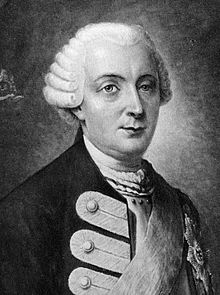
Back فريدريتش ويلهيلم كويرين ڤون فوركاد د بيايكس ARZ Friedrich Wilhelm Quirin von Forcade German Friedrich Wilhelm Quirin von Forcade French
His Excellency[1] Lieutenant General, Sir Friedrich Wilhelm Quirin von Forcade de Biaix | |
|---|---|
 c. 1758 | |
| Born | Quirin Frideric de Forcade[2] 11 January 1699[2] |
| Died | 23 March 1765[1] |
| Burial place | Family vault in the crypts under the Garnisonkirche, Berlin (before 1949)[1] Südwestkirchhof Stahnsdorf (after 1949) |
| Title | Domherr of Havelberg Drost in Neuenrade Amtshauptmann of Zinna President of the Ober-Collegium Sanitatis Lieutenant governor of Breslau |
| Spouse | Marie de Montolieu, Baroness de Saint-Hippolyte (1727) |
| Children | 23, of which 4 stillborn, most notably: Friedrich Wilhelm von Forcade de Biaix Charlotte Sophie Therese Marthe von Forcade Georg Friedrich Wilhelm von Forcade de Biaix Friedrich Heinrich Ferdinand Leopold von Forcade de Biaix |
| Parent(s) | Lieutenant General Sir Jean de Forcade de Biaix and Juliane Freiin von Hoenstedt |
| Military career | |
| Allegiance | |
| Service/ | Prussian Army |
| Rank | Lieutenant General |
| Unit | 1st White Fusilier Guards, under the 1st Prussian Infantry Regiment (1713-1721) 23rd Prussian Infantry Regiment (1721-1757) |
| Commands | 23rd Prussian Infantry Regiment (14 July 1748) Commandant of Berlin (14 July 1748) Adjutant General to King Frederick the Great (24 December 1756) Prussian Infantry at the Battle of Breslau (16 February 1757) |
| Battles/wars | |
| Awards | Knight of the Order of Pour le Mérite Knight of the Order of the Black Eagle[3] |
| Memorials | Equestrian statue of Frederick the Great, north facing commemorative plaque |
Friedrich Wilhelm Quirin von Forcade de Biaix,[4] baptized Quirin Frideric de Forcade, aka Friedrich Quirin von Forcade, aka Frédéric Quérin de Forcade[5] (* 11 January 1699,[2] Berlin;[2] † 23 March 1765,[2] Berlin[1]), was a Kingdom of Prussia Lieutenant General,[1][6][7] the second son of Jean de Forcade de Biaix, an early Huguenot immigrant to Brandenburg-Prussia and a descendant of the noble family of Forcade. He was one of Frederick the Great's most active and most treasured officers.[8][9] He was wounded three times and once left for dead on the battlefield. Together with his wife, he fathered 23 children.[8]
He was Regimentschef of the 23rd Prussian Infantry Regiment,[7] recipient of the Kingdom of Prussia's highest military order of merit for heroism, Knight of the Order of Pour le Mérite,[4] Knight of the Order of the Black Eagle,[3] Canon (German: Domherr) of Havelberg,[4] Castellan (German: Drost) in Neuenrade in the County of Mark,[6] Lord Seneschal (German: Amtshauptmann) of Zinna,[6] President of the Ober-Collegium Sanitatis in Berlin and Lieutenant governor of Breslau.[7]
In 1851, his name was place on the north facing commemorative plaque on the Equestrian statue of Frederick the Great in Berlin.
- ^ a b c d e f Berlin-Friedrichstadt, Deaths Vol. 1748-1773 p. 548 (in French manuscript) (subscription required)
- ^ a b c d e f Berlin-Friedrichstadt, Baptisms Vol. 1673-1704, p. 391 (in French manuscript) (subscription required)
- ^ a b Königlich Preußischer Hoher Orden vom Schwarzen Adler (1871), p. 20 (in German)
- ^ a b c Lehmann, Band 1, Page 34, Nr. 245 (in German)
- ^ Tollinen, Band III, Abteilung 1B, Page 72 (in German)
- ^ a b c König, Band 1, Page 430 (in German)
- ^ a b c Heinsius, Issue 52, Page 241, Nr. V (in German)
- ^ a b Zedlitz-Neukirch, Band 2, Page 179 (in German)
- ^ Zedlitz-Neukirch, Band 4, Page 390 (in German)